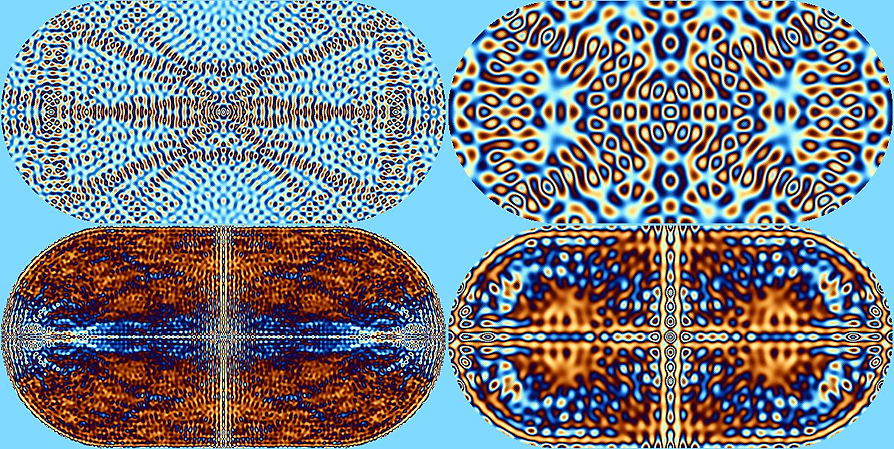The main mystery is this: a single particle (an electron, neutron, quark, etc.) acts as a wave until it is measured--to put it simply, when you "look" at a particle to measure where it is exactly, it collapses into a point in spacetime. We as observers are unable to know exactly where a particle is without condensing it into 4 dimensions.
Wait--condensing? Isn't that like limiting?
Well, yes. I've come to the conclusion (theoretical conclusion, mind you) that wave functions, or probability waves if you prefer, actually exist outside the 4th dimension of time.
I think all fundamental particles (including our own consciousness, which I'll get to later) exist in this way outside of observation.
Okay. Back to the double-slit experiment. It's amazing how a single particle can act as many particles in the form of a wave. Scientists have delineated this strange phenomenon as the probability wave--basically, anywhere a particle can be, it is. A particle follows every possible trajectory at the exact same moment.* Until we "look" at it. When we observe its location, all the trajectories collapse into one--the one where it "actually" is.
 |
| A simple depiction of a collapsed wave function |
It's the same sort of idea that fans of parallel universes like to bring up. Imagine you're sitting at your computer right now, reading this post. Maybe your arm is resting on the desk, or maybe it's in your lap. Maybe you have a steaming cup of coffee next to you, or your cat is lying under your chair. Maybe in the next room your roommate is yelling at the TV screen, testing your concentration on this subject (however stoic you may be). Then imagine all the trajectories you could possible take from here. You could scratch your nose. You could lift your hand halfway to your nose and then lay it back down because you're too lazy to finish the task. You could turn your head and stare longingly out the window. You could get up and refill your coffee.
And these are large shifts. Imagine every particle in your body and all the trajectories they can take without you even moving. It's mind-boggling. So imagine infinite parallel universes where infinite identical yous make this decision or that decision that creates this or that effect. And remember that even the tiniest shift from one universe to the next creates a parallel universe. Everything may be exactly the same in this universe as in another, until the point when your stomach gurgles at 3:47pm instead of 3:46pm.
Some theoretical physicists believe that the probability wave is just a clear look into parallel worlds. The particle can exist everywhere possible at the same moment because it is--in other worlds. But to me that doesn't explain why we experience this phenomenon (I'm not convinced of the multiverse theory just yet).
My theory is that probability waves are how particles act and exist outside the dimension of time.
First, let me explain what I think about time in relation to mass.
Certain particles such as photons (electromagnetism), gauge bosons, and gluons (strong force), have a theoretical mass equal to zero. This means, as a result, that they do not experience time. You've probably heard the well-worn science fiction sentiment that if we could just reach the speed of light, or travel faster than the speed of light, we could travel in time. Well, that may be true. Why? Because photons, like the other massless particles, exist outside the 4th dimension.
Mass and time are two parts of the same whole.
The larger the mass, the more spacetime is affected (i.e. warped). If you stand next to the great pyramids in Egypt and your friend, whose watch is calibrated to the exact same time as yours, stands 10 miles off in the desert, you'll find upon your reunion that your watch has ticked slightly slower. Of course the slowing of time due to proximity of massive objects is hard to measure and in our world turns out to be quite minuscule--but that's not the point. The point is that mass affects time.
 |
| Example of massive object warping the fabric of spacetime |
If you think about it, time warps according to an object's mass, which accounts for relativity. Gravity and time are substances linked to mass. Gravity has gravitons, and time... well, one day we may find the time particle. But if only massless objects experience timelessness, then mass produces time, or time produces mass. You can't have one without the other. It's more likely that mass produces time because it's an objects mass that creates its gravitational field, which in turn warps time. I think the mere existence of an object with mass produces spacetime--a point along the spectrum where and when physical existence can occur.
Let's move now toward a more metaphysical subject: consciousness.
It's like the wave function. Without our physical bodies--without our masses--we, too, would be timeless. Our consciousness expresses itself as waves. We've measured brain waves, and those are the physical ghosts of what our nonphysical consciousness is doing. Because we have a mass, we experience time; the wave function of our consciousness is collapsed.
That is why, when a wave function is observed by a computer detector or a human scientist, it collapses--because the massive objects observing the wave force the wave into the spectrum of space and time. If particles could not collapse into one point in space and time, we would not be able to observe or measure them because we exist in space and time.
The wave function is a 5th dimensional force. Our consciousness is made up of the same force that all fundamental particles exhibit when released from the time spectrum--we can exist anywhere, at any time. We become a series of probabilities. We can follow each and every trajectory open to us all at the same time. Like the single particle acting as many interacting particles, our consciousness can move to the 5th dimension and interact with all other consciousness.
Think of wave functions and consciousness (which are, in my theory, the same thing) as a kind of bloodstream floating above the spectrum of time and space. When we try to observe the wave (or consciousness) from within 4 dimensions, we're pulling down a single trajectory from the probabilities with which to interact. The wave cannot exist as a wave within our 4 dimensional world.
Time is as malleable and changeable as the other universal forces. It has different values at different points in space which correspond to a) speed, and b) gravity. Velocity and mass are equal to energy. Photons, though they have no mass, do have energy--they are simply the expression of energy unrestrained by time. I believe this is what consciousness is. Because we are physical beings with a mass, we cannot exist outside of time. However, if we learn how to enter the 5th dimensional bloodstream by tapping into our consciousness's wave function (there are plenty of ways to do this; astral projection, meditation, lucid dreaming, etc.) we can experience existence beyond the spectrum of time. We can go anywhere at any moment.
I wonder what it would be like to exist as a wave...
*See Chapter 8 of Brian Greene's The Hidden Reality.




























